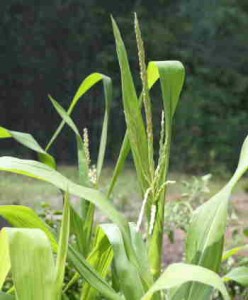We have been watching our little stand of corn each week, hoping to see signs of tassels forming at the tops of the plants. We spotted them this week, and they announce that our corn plants have entered a new phase of their lives.
Tassels are the sign of a fundamental shift in priorities for a corn plant. Before it forms a tassel, a corn plant pours all its energy into the development of its robust stalk, leaves, and roots. Once it forms a tassel (actually its male flower), it has finished developing that stalk, leaves and roots; it will get no larger. From that point forward, its sole purpose in life is to pollinate and produce kernels of corn. And for this we are all grateful.
Now before I get carried away, I need to tell you that our corn is short. Not only is it well short of an elephant’s eye, it would struggle to brush an elephant’s knee. What we are growing is heirloom corn from Seed Savers Exchange, not the hybrid stuff so fashionable today, so we’re inclined to trust that this is the right height for it. But we will be watching it closely in hopes of seeing signs of fruiting.
 If you’re into this sort of thing (and if you’re not why are you reading this?), click on the photo so you can see it more clearly. That tall stalk in the center is called the center stalk, and the branches form around it. Both the center spike and the branches are covered with spikelet flowers, each of which deploys antlers that actually hold and release the pollen. That stalk of corn you see in the photo, if God is in Her heaven and all goes according to plan, will release more than a million grains of pollen over a period of a week or so. All of this comprises the male flower. Each female flower will eventually become a kernel of corn, with its own silk running back to the base of the corn branch. There are 2,000 to 5,000 grains of pollen for each corn kernel, so Mother Nature has built in a margin for error.
If you’re into this sort of thing (and if you’re not why are you reading this?), click on the photo so you can see it more clearly. That tall stalk in the center is called the center stalk, and the branches form around it. Both the center spike and the branches are covered with spikelet flowers, each of which deploys antlers that actually hold and release the pollen. That stalk of corn you see in the photo, if God is in Her heaven and all goes according to plan, will release more than a million grains of pollen over a period of a week or so. All of this comprises the male flower. Each female flower will eventually become a kernel of corn, with its own silk running back to the base of the corn branch. There are 2,000 to 5,000 grains of pollen for each corn kernel, so Mother Nature has built in a margin for error.
Amanda’s recently been working on planting Three Sisters in the perimeter of the garden. She promises a post about it, but she has given me permission to tease you with a little information about it. Three Sisters is the ancient Native American practice of growing corn, beans, and squash together.
The beans climb on the corn, and in return fix nitrogen in their roots for next year’s squash and corn. The bean vines also provide stability for the corn stalks that helps them withstand rough winds. The big squash leaves shade the ground and thereby keep the weeds under control that would otherwise pester the corn and beans. They also slow down evaporation of moisture from the soil. Because the Three Sisters play so happily together, we understand if we are careful to mulch the spent stalks and leaves each year, we could plant them in the same ground continuously for decades, with the soil becoming richer each year. Amanda loves the idea of substituting pumpkin for squash every now and then, so we plan to do that.